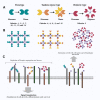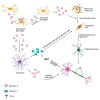Galectins-Potential Therapeutic Targets for Neurodegenerative Disorders
- PMID: 36232314
- PMCID: PMC9569834
- DOI: 10.3390/ijms231911012
Galectins-Potential Therapeutic Targets for Neurodegenerative Disorders
Abstract
Advancements in medicine have increased the longevity of humans, resulting in a higher incidence of chronic diseases. Due to the rise in the elderly population, age-dependent neurodegenerative disorders are becoming increasingly prevalent. The available treatment options only provide symptomatic relief and do not cure the underlying cause of the disease. Therefore, it has become imperative to discover new markers and therapies to modulate the course of disease progression and develop better treatment options for the affected individuals. Growing evidence indicates that neuroinflammation is a common factor and one of the main inducers of neuronal damage and degeneration. Galectins (Gals) are a class of β-galactoside-binding proteins (lectins) ubiquitously expressed in almost all vital organs. Gals modulate various cellular responses and regulate significant biological functions, including immune response, proliferation, differentiation, migration, and cell growth, through their interaction with glycoproteins and glycolipids. In recent years, extensive research has been conducted on the Gal superfamily, with Gal-1, Gal-3, and Gal-9 in prime focus. Their roles have been described in modulating neuroinflammation and neurodegenerative processes. In this review, we discuss the role of Gals in the causation and progression of neurodegenerative disorders. We describe the role of Gals in microglia and astrocyte modulation, along with their pro- and anti-inflammatory functions. In addition, we discuss the potential use of Gals as a novel therapeutic target for neuroinflammation and restoring tissue damage in neurodegenerative diseases.
Keywords: Gal-1; Gal-3; Gal-9; galectins; neurodegeneration; neuroinflammation; targeted therapy.
Conflict of interest statement
The authors have no conflict of interest to declare that are relevant to the content of this article.
Figures
References
-
- Md Ashraf G., Perveen A., Tabrez S., Jabir N.R., Damanhouri G.A., Zaidi S.K., Banu N. Altered galectin glycosylation: Potential factor for the diagnostics and therapeutics of various cardiovascular and neurological disorders. Adv. Exp. Med. Biol. 2015;822:67–84. doi: 10.1007/978-3-319-08927-0_10. - DOI - PubMed
Publication types
MeSH terms
Substances
LinkOut - more resources
Full Text Sources
Medical
Research Materials




